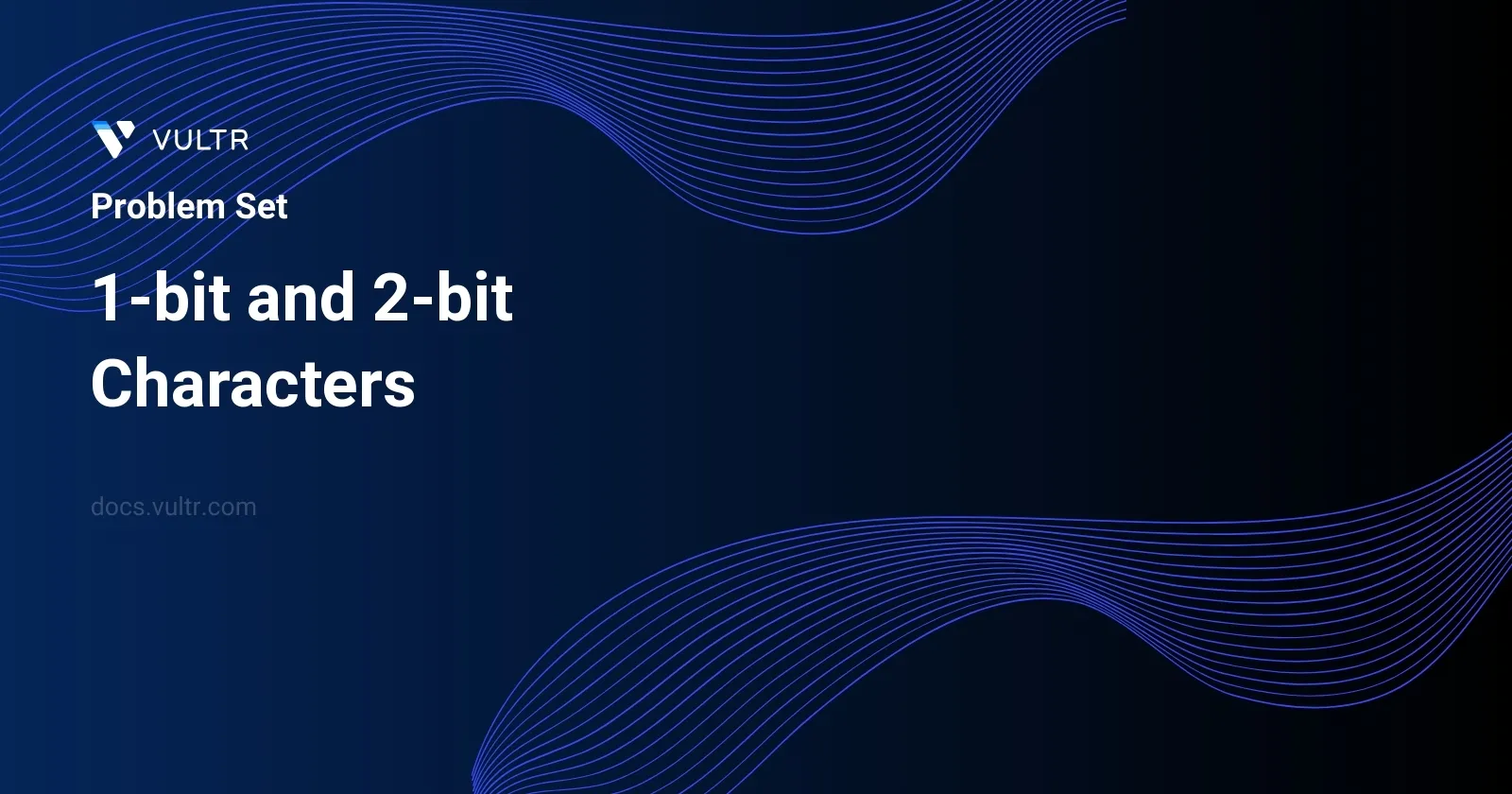
Problem Statement
In the context of binary encoding standards, let's consider a hypothetical situation involving two types of characters. The first character type is encoded as a single bit 0, whereas the second character type uses a two-bit pattern, either 10 or 11. Given an array of binary digits called bits that concludes with a 0, the task is to determine whether the final character represented by the bits is a one-bit character. Simply put, if the sequence ends with a 0, we need to ascertain if this 0 stands alone as a one-bit character (True) or is part of a two-bit character (False).
Examples
Example 1
Input:
bits = [1,0,0]
Output:
true
Explanation:
The only way to decode it is two-bit character and one-bit character. So the last character is one-bit character.
Example 2
Input:
bits = [1,1,1,0]
Output:
false
Explanation:
The only way to decode it is two-bit character and two-bit character. So the last character is not one-bit character.
Constraints
1 <= bits.length <= 1000bits[i]is either0or1.
Approach and Intuition
The challenge revolves around traversing the bits array and accurately identifying whether the last bit (0 in every case due to the constraints) is a standalone bit or part of a preceding two-bit character. Here's how you can intuitively think about the solution:
- Initialize a Pointer: Start from the first element of the array.
- Traverse and Decode:
- If you encounter a
0, this is a one-bit character. Move your pointer to the next bit. - If you encounter a
1, this must be part of a two-bit character (10or11). Therefore, skip the next bit as well, moving your pointer two steps forward.
- If you encounter a
- End Condition: Since the array is always terminated by
0, check the position of your pointer:- If your pointer lands on the last bit (
0), then it interprets it as a one-bit character. - If it moves beyond the last bit (
0), this suggests the last0was part of the previous two-bit character.
- If your pointer lands on the last bit (
This assessment technique effectively uses the properties of the encoding to decode until the penultimate entry, determining the nature of the final 0. Considering the constraints:
- The array's length will always allow for this sequential interpretation without running out of bounds.
- Each element is strictly a binary digit, which is conducive for straightforward condition checks in the traversal algorithm.
Solutions
- C++
- Java
class Solution {
public:
bool checkBitCharacter(vector<int>& data) {
int index = data.size() - 2;
while (index >= 0 && data[index] > 0) {
index--;
}
return (data.size() - index) % 2 == 0;
}
};
The given C++ solution addresses the problem of determining if the last character of a string, represented by a vector of bits, is a 1-bit character. The 1-bit character is represented by 0, and there are also 2-bit characters represented as 10 or 11. The identification process involves the following logic:
- Start from the second to last element in the array (i.e.,
data.size() - 2) because the last element is assumed to be the start of the last character. - Traverse backwards through the array, decrementing the index as long as the element at the current index is greater than 0 (which represents the part of a 2-bit character, either
1of10or11). - Stop when a 0 is encountered, marking the potential start of a 1-bit character or the boundary between character sequences.
- After escaping the loop, check the total number of bits (excluding the identified start of last character at the found position) to determine the nature of the last character. If the count of elements from the found position to the end of the vector is odd, this implies the last character is a 1-bit character (
0). Otherwise, it is not.
The core of the method leverages modular arithmetic to ascertain whether the segment length from the identified index to the end is even or odd, effectively determining the type of the last character. This method is efficient, scanning the vector from end to start only once and using simple arithmetic operations.
class Solution {
public boolean isSingleBitCharacter(int[] data) {
int index = data.length - 2;
while (index >= 0 && data[index] == 1) {
index--;
}
return (data.length - index) % 2 == 0;
}
}
This Java solution addresses the problem of determining whether the last character of a bit array is represented by a single bit. The thought process behind the solution involves iterating backwards from the second to last element of the array, checking for a sequence of 1s. When the sequence ends or if the start of the array is reached, the code checks if the count of steps needed to reach that point results in a sequence that would allow the final character to be a single bit. The key here is understanding that the alternation between sequences formed by bits can affect whether the last bit stands alone or not. Specifically, the implementation:
- Initializes an index pointing just before the last element of the array.
- Moves backward through the array until either a zero is found or it reaches the array's start.
- Checks if the distance from the end of the array to the index is even. If it is, then the last character is a single bit; otherwise, it is not. This conclusion is based on how pairs of ones affect the partitioning of the array into character units.
This method is efficient since it checks from the end of possible sequences involving multi-bit characters and quickly determines the nature of the last bit without having to process the entire array sequentially.